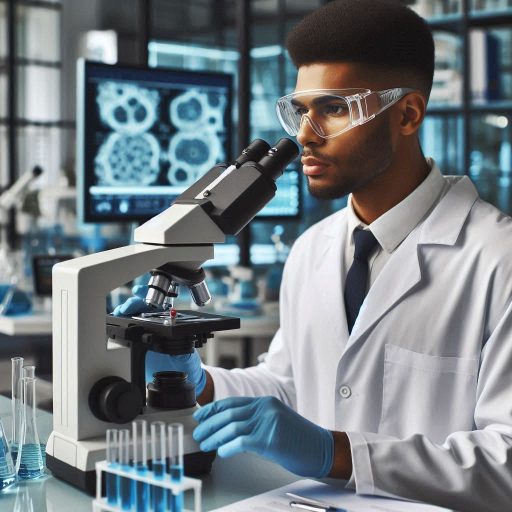Introduction
Biomedical engineering is a multidisciplinary field that blends biology, medicine, and engineering.
It applies engineering principles to solve medical challenges.
Biomedical engineers design medical devices, develop diagnostic tools, and improve therapeutic procedures.
Their work enhances patient care, from creating advanced prosthetics to designing sophisticated imaging systems.
In healthcare, biomedical engineering plays a crucial role.
It supports the development of life-saving technologies and improves medical treatments.
Biomedical engineers design and test equipment that ensures accurate diagnoses and effective treatment outcomes.
They also work on improving the safety, efficiency, and affordability of healthcare solutions.
Collaboration between biomedical engineers and medical professionals is essential for innovation.
Medical professionals provide firsthand knowledge about patient needs and clinical challenges.
Biomedical engineers, in turn, use this input to create practical solutions.
Their collaboration accelerates the development of technologies that meet the demands of modern medicine.
Effective teamwork between these two groups ensures that medical devices meet regulatory standards and clinical requirements.
Together, they ensure medical innovations are both safe and effective.
This collaboration is essential for developing devices that truly benefit patients and healthcare providers alike.
Role of Biomedical Engineers
Specific Responsibilities of Biomedical Engineers in Healthcare
Biomedical engineers play a crucial role in advancing healthcare.
They blend engineering principles with medical knowledge to solve complex healthcare challenges.
Their responsibilities are broad and vary depending on their specialization.
However, they focus on designing and developing medical devices and technologies that enhance patient care.
A significant part of their job involves creating innovative medical devices like prosthetics, artificial organs, and diagnostic machines.
These devices assist medical professionals in delivering more accurate and efficient care.
Biomedical engineers also work on refining existing technologies, ensuring they meet safety and efficacy standards.
In addition, they often work with materials scientists to develop biocompatible materials for implants and tissue engineering.
This collaborative effort helps ensure that new devices and materials interact safely with the human body.
Another critical responsibility is conducting research to develop new techniques in areas such as medical imaging, drug delivery systems, and biomaterials.
Biomedical engineers are also responsible for maintaining and troubleshooting medical equipment in hospitals and clinics.
They ensure that devices operate correctly and efficiently.
This reduces downtime in hospitals, ensuring that patients receive uninterrupted care.
Furthermore, they train healthcare staff to use new technologies, ensuring smooth integration into clinical settings.
The Impact of Biomedical Engineering on Improving Patient Care
Biomedical engineering has revolutionized patient care.
By developing advanced medical technologies, biomedical engineers enable earlier diagnosis and more effective treatment.
For instance, modern imaging systems such as MRI, CT scans, and ultrasound machines provide detailed, non-invasive views inside the body.
These devices have improved diagnostic accuracy, allowing healthcare providers to detect conditions earlier.
In addition to diagnostics, biomedical engineers have improved therapeutic options for patients.
Technologies like pacemakers, insulin pumps, and artificial limbs provide patients with better quality of life.
These advancements allow patients to manage chronic conditions more effectively, promoting independence and longer lifespans.
Another key area where biomedical engineering has made an impact is in surgical procedures.
Minimally invasive techniques, such as laparoscopic surgery, are made possible by innovations from biomedical engineers.
These procedures reduce recovery times, minimize pain, and lower the risk of complications.
Biomedical engineers also contribute to the development of personalized medicine.
By designing devices and technologies tailored to individual patients, they allow for more customized treatment plans.
This approach improves treatment success rates and enhances patient satisfaction.
The advancements in medical devices and treatment techniques have resulted in better patient outcomes.
Shorter recovery times, fewer complications, and improved quality of life are direct results of biomedical engineering innovations.
Biomedical engineers continue to push the boundaries of what‘s possible, directly benefiting patient health.
The collaboration between biomedical engineers and medical professionals is vital in advancing healthcare.
Their expertise drives innovation, ensuring that patient care and outcomes continually improve.
Read: Profiles in Success: Leading Chemists of the 21st Century in the US
Benefits of Collaboration
Collaboration Between Biomedical Engineers and Medical Professionals Enhances Innovation in Medical Technology
Biomedical engineers and medical professionals work together to drive innovation in medical technology.
By combining engineering expertise with clinical knowledge, they can solve complex healthcare problems more effectively.
This collaboration leads to the creation of new devices, diagnostic tools, and treatment options.
Medical professionals identify the specific needs within healthcare environments.
They bring real-world experience and insights from direct patient care.
Biomedical engineers then use this input to design and refine technologies that address those needs.
By working together, they ensure that new innovations are both practical and effective in real-life medical settings.
For example, doctors might identify issues with existing medical equipment.
Biomedical engineers can then analyze these problems and develop solutions to improve functionality or safety.
Together, they create devices that better serve patients and healthcare providers.
This back-and-forth exchange of ideas fosters continuous improvement and innovation.
Collaboration also accelerates the development process.
Biomedical engineers often rely on medical professionals to test prototypes in clinical environments.
Feedback from doctors and nurses allows engineers to refine designs more quickly.
This speeds up the time it takes to bring new technologies to market, benefiting patients sooner.
Ultimately, teamwork between biomedical engineers and healthcare professionals drives the creation of cutting-edge medical technologies.
These innovations can save lives, reduce recovery times, and improve overall healthcare outcomes.
The Role of Interdisciplinary Teamwork in Developing Healthcare Solutions
Solving complex healthcare challenges requires an interdisciplinary approach.
Biomedical engineers and medical professionals work together, but they also collaborate with other specialists.
This includes fields such as data science, materials science, and pharmacology.
In interdisciplinary teams, each member contributes unique expertise.
For example, biomedical engineers may design a medical device, but data scientists analyze the device’s performance in real-world settings.
Pharmacologists could work alongside them to explore how new technologies interact with medications.
By pooling their skills, the team develops more comprehensive solutions to healthcare problems.
Communication is key to effective interdisciplinary collaboration.
Professionals from different fields must share information clearly and frequently.
This exchange helps them identify potential issues early and develop more holistic solutions.
When experts work together, they can create innovations that address multiple aspects of healthcare challenges at once.
For instance, developing a new robotic surgery tool requires engineers to design precise mechanisms, surgeons to assess usability, and materials scientists to ensure durability and safety.
Each discipline plays a vital role in the process.
Without this teamwork, the final product would be less effective.
Interdisciplinary collaboration also fosters creativity.
When professionals from diverse backgrounds exchange ideas, they can approach problems from different perspectives.
This leads to novel solutions that may not have emerged in a single-discipline environment.
As a result, interdisciplinary teams are better equipped to tackle the complex and evolving challenges of modern healthcare.
The partnership between biomedical engineers, medical professionals, and other experts is essential for driving innovation and solving healthcare problems.
This teamwork leads to safer, more effective medical technologies that improve patient care.
Read: The Life and Times of a U.S. Physicist: A Day in Detail
Examples of Collaboration
Case Studies of Successful Collaborations Between Biomedical Engineers and Medical Professionals
Biomedical engineers and medical professionals often work closely to drive innovation in healthcare.
These partnerships lead to advancements in medical technology that improve patient care.
Below are some notable examples where these collaborations have produced significant results.
The Development of the Artificial Heart
One prominent case is the development of the artificial heart.
Biomedical engineers worked alongside cardiologists and surgeons to create a life-saving device for patients with end-stage heart failure.
Engineers designed a pump to replicate heart function, while medical experts ensured it met clinical standards.
In 1982, Dr. Barney Clark received the first permanent artificial heart, thanks to collaboration between engineers from the University of Utah and Dr.
Barney Jarvik‘s surgical team.
Since then, this partnership has led to improved versions of artificial hearts and ventricular assist devices.
The development of cochlear implants is another success story.
Biomedical engineers collaborated with audiologists and otolaryngologists to address hearing loss.
Engineers focused on developing the implant technology, while medical professionals identified patient needs and limitations.
Since the introduction of the first cochlear implants in the 1970s, technological improvements have provided clearer sounds and speech recognition.
This collaborative effort has enhanced the quality of life for millions of hearing-impaired individuals worldwide.
Collaboration between biomedical engineers and orthopedic surgeons has revolutionized prosthetics.
Standard prosthetics often didn‘t fit patients perfectly.
Engineers, using 3D printing technology, worked with surgeons to design custom prosthetics tailored to each patient‘s anatomy.
One notable case involved a patient with a complex bone tumor.
Biomedical engineers created a 3D-printed titanium implant that replaced the affected bone.
This partnership resulted in a breakthrough for personalized medical treatments, allowing surgeons to provide better-fitting, functional prosthetics.
How These Collaborations Have Led to Advancements in Medical Devices, Treatments, and Procedures
The successful collaboration between biomedical engineers and medical professionals has led to major advancements in healthcare.
These partnerships result in improved medical devices, treatments, and procedures that greatly benefit patients.
Minimally Invasive Surgery
Minimally invasive surgery has been revolutionized by biomedical engineers collaborating with surgeons.
Laparoscopic procedures, which require small tools maneuvered through tiny incisions, are one example.
Engineers designed these tools, allowing for greater precision and faster recovery times.
Robotic surgery systems, like the Da Vinci Surgical System, were also developed through such collaborations.
Engineers designed the robotic arms, while surgeons helped integrate the technology safely into operating rooms.
These advancements have resulted in more precise, less invasive surgeries, reducing pain and recovery time for patients.
The collaboration between biomedical engineers and medical professionals is transforming healthcare.
By merging technical and clinical expertise, they continue to innovate, creating new medical devices, treatments, and procedures that enhance patient care and quality of life worldwide.
Read: Salary Ranges: What to Expect as a Physicist in the USA

You Might Also Like: Essential Skills Every Toxicologist Should Master
You Might Also Like: Career Transition: From Biology to Ecology
Challenges and Solutions
Common Obstacles in Collaboration Between Biomedical Engineers and Medical Professionals
Collaboration between biomedical engineers and medical professionals is essential for advancing healthcare, but it often faces challenges.
These obstacles can hinder progress, delay innovation, and create misunderstandings.
Let‘s examine some of the common barriers to effective teamwork.
Differing Professional Languages
Biomedical engineers and medical professionals often speak different professional languages.
Engineers use technical terms related to design, mechanics, and electronics, while medical professionals focus on biology, physiology, and clinical care.
This gap in understanding can cause confusion and miscommunication.
Engineers often focus on developing innovative, efficient solutions, while medical professionals prioritize patient safety and clinical practicality.
These differing priorities can lead to conflicting approaches when designing medical devices or treatments.
Engineers may overlook clinical constraints, and medical professionals may underestimate technical limitations.
Medical professionals frequently have demanding schedules that limit their time for collaboration.
Biomedical engineers may need more time to understand medical requirements thoroughly.
This time mismatch can delay decision-making, project execution, and progress toward shared goals.
Regulatory and Ethical Concerns
Regulations in the medical field are stringent, and biomedical engineers may not always be fully aware of these legalities.
Medical professionals, on the other hand, need to ensure that every innovation complies with regulatory standards and ethical guidelines.
These legal challenges can slow down the collaboration process.
Budgetary limitations can affect the ability to implement innovative solutions.
Engineers may propose cutting-edge technologies that are too costly for healthcare facilities to adopt.
Medical professionals often need to balance budgets, and this conflict can limit what is realistically achievable in a collaborative project.
Strategies for Overcoming These Challenges and Fostering Effective Communication and Teamwork
Although challenges exist, overcoming them is possible through effective strategies.
Here are some ways biomedical engineers and medical professionals can foster better collaboration and communication.
Bridging the communication gap is essential.
Both teams should make an effort to understand each other’s terminologies.
Engineers can take time to learn medical terminology, while medical professionals can familiarize themselves with the basics of engineering.
This shared understanding helps improve communication and reduces confusion during discussions.
Early alignment of priorities can reduce conflicts later in the project.
Both engineers and medical professionals should clearly define their goals, limitations, and requirements at the start of any collaboration.
Regular meetings to revisit these priorities will ensure that both teams remain aligned throughout the project.
Improving Time Management and Flexibility
Time management is crucial.
Biomedical engineers can adopt flexible work schedules to accommodate medical professionals‘ availability.
Scheduling regular, shorter meetings instead of long, infrequent ones can also help keep both teams on track without overburdening either side.
Both engineers and medical professionals should collaborate early on to understand the regulatory and ethical requirements for a project.
Legal advisors can be brought in to help both parties navigate complex rules.
This proactive approach ensures compliance and prevents legal obstacles from slowing the project.
Both teams must work together to find solutions that are both innovative and cost-effective.
Engineers can design modular or scalable systems that are affordable while still delivering high-quality care.
Medical professionals should provide input on cost constraints from the start, helping engineers design within budget.
Effective collaboration between biomedical engineers and medical professionals requires overcoming several challenges.
By addressing communication barriers, aligning priorities, managing time efficiently, navigating regulations, and considering budgets, both teams can work together more successfully.
These strategies ultimately lead to innovative solutions that improve patient care and advance medical technology.
Read: Physics Specializations: Choosing Your Path in the U.S.
Transform Your Career Today
Unlock a personalized career strategy that drives real results. Get tailored advice and a roadmap designed just for you.
Start NowDelve into the Subject: Top Universities for Botany Studies in America
Future Trends
Emerging Technologies in Biomedical Engineering Shaping Healthcare
Biomedical engineering is at the forefront of revolutionizing healthcare with cutting-edge technologies.
Engineers and medical professionals now collaborate more closely than ever.
This partnership is driven by emerging innovations that enhance diagnostic accuracy, treatment efficacy, and patient outcomes.
Artificial Intelligence (AI) and Machine Learning in Healthcare
AI and machine learning are transforming healthcare systems.
Biomedical engineers design algorithms that assist doctors in diagnosing diseases faster.
These tools analyze vast amounts of medical data and provide insights for early detection and personalized treatment plans.
AI-powered imaging tools, for example, help radiologists identify abnormalities in X-rays and MRIs more precisely.
This seamless collaboration allows medical professionals to access AI-driven insights in real time.
As these technologies evolve, they will improve decision-making and streamline patient care workflows.
Another revolutionary technology is 3D printing.
Biomedical engineers create customized medical devices, including prosthetics and implants, tailored to individual patients.
This trend shifts the traditional one-size-fits-all approach to a more personalized one.
Collaboration between engineers and healthcare providers is crucial in refining these devices.
Surgeons work with engineers to ensure these custom-designed tools fit patients’ needs and improve surgical precision.
Wearable Health Technologies
Wearable devices have become integral to modern healthcare.
Engineers develop smartwatches, fitness trackers, and medical-grade wearables that monitor vital signs in real time.
These devices collect data that can be shared with medical professionals for continuous patient monitoring.
With remote patient monitoring on the rise, this trend fosters better communication between healthcare providers and patients.
It also enables proactive interventions, reducing hospital visits and improving chronic disease management.
Tissue engineering is another area where biomedical engineers collaborate with medical experts.
Engineers now create synthetic tissues and organs to repair or replace damaged body parts.
This emerging field offers hope for patients suffering from degenerative diseases or organ failure.
Medical professionals work closely with engineers to test and implement these innovative treatments.
This collaboration could reduce organ transplant shortages and revolutionize patient care.
The Impact of Emerging Technologies on Collaboration
These emerging technologies are reshaping how biomedical engineers collaborate with medical professionals.
AI allows doctors to access deeper data insights, while 3D printing and tissue engineering offer new avenues for personalized treatment.
Wearables enable continuous monitoring, bridging the gap between healthcare providers and patients.
As these advancements evolve, the collaboration between engineers and doctors will only strengthen.
Together, they will continue to drive innovation in healthcare, improving patient outcomes and shaping the future of medicine.
The partnership between biomedical engineers and medical professionals will remain vital as these technologies further integrate into everyday healthcare.
By working together, they ensure that emerging technologies are applied effectively, benefiting both patients and the healthcare industry.
Conclusion
Collaboration between biomedical engineers and medical professionals drives healthcare innovation.
Together, they develop solutions that improve patient outcomes and streamline clinical processes.
Biomedical engineers use their technical expertise to design and optimize medical devices, diagnostics, and treatment technologies.
Medical professionals bring practical knowledge of patient needs, offering real-world insight that shapes these innovations.
In the blog, we discussed how biomedical engineers work with doctors, nurses, and surgeons to address healthcare challenges.
Through collaboration, they design technologies that meet safety standards while enhancing precision and efficiency.
This partnership leads to breakthroughs in areas like prosthetics, medical imaging, and personalized medicine.
Effective collaboration is crucial for translating cutting-edge research into usable medical tools.
Both fields complement each other, with biomedical engineers creating innovations and medical professionals validating their effectiveness.
This symbiotic relationship ensures that technologies are both innovative and patient-centered, improving healthcare delivery overall.
Biomedical engineers collaborate with healthcare professionals to innovate, create solutions, and enhance patient care.
Their combined expertise accelerates progress in medical technology, directly benefiting patients and transforming healthcare systems worldwide.
This collaboration is vital for driving healthcare advancements and ensuring that new technologies are practical, safe, and effective.
[E-Books for Sale]
The Big Book of 500 High-Paying Jobs in America: Unlock Your Earning Potential
$19.99 • 500 High-Paying Jobs • 330 pages
Explore 500 high-paying jobs in America and learn how to boost your career, earn more, and achieve success!
See All 500 High-Paying Jobs of this E-Book
1001 Professions Without a Degree: High-Paying American Jobs You Can Start Now
$19.99 • 1001 Professions Without a Degree • 174 pages
Discover 1001 high-paying jobs without a degree! Unlock career tips, skills, and success strategies for just $19.99!




